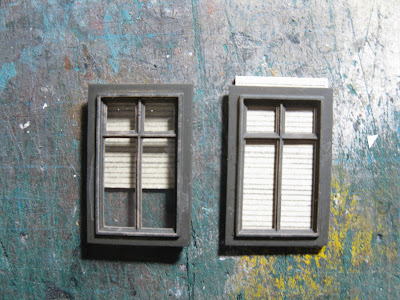Scale windows are always a tricky thing and they really gets realistic only if you play with depth. Many have instead used photos to produce much more interesting results as advocated by Lance Mindheim. I think it is a worthy technique, particularly with some kind of windows that are hard to get right in smaller scales. However, I wanted to experiment a little bit more with Drummondville station.
The easiest way to make your windows look more realistic is dressing them up. May it be curtains or blinds, they create a sense of occupancy into what could be a soulless and empty structure. Unfortunately, simply gluing paper blinds behind the glazing doesn't cut it for me... and you'll see why!
 |
| Left: blinds spaced behind the glazing, Right: blinds against the glazing |
When I started to dress up my windows, I embossed some paper with a metal awl then painted it. I glued it against the glazing and it didn't look great. Unfortunately, the scribed lines didn't show up that much and I had to add a line of shadow with a pencil. At this point, I figured out simply drawing the blinds with a pencil would be much more efficient and aesthetic. Also, it became clear it wasn't realistic to have blinds right against the glazing, even in HO scale. In real life, blinds are generally a few inches from the windows, somewhere between 4 to 8 inches depending on the wall thickness. I the case of Drummondville station, which has 16" thick brick walls, it was required to account for a 1.5mm spacing.
Thus, I decided to add 1.5 thick strips on cardboard on the back of the windows to create walls. I painted these dark brown because I didn't want to draw attention to them from the outside. Depending on your prototype, keeping them white could be a good idea if it gives a nice effect. I didn't care about adding strips at the top and bottom because I found out they didn't have any significant visual impact. However, next time I design windows, I'll probably fully frame the perimeter. In fact, it could be done on the 3D print to save time and material.
I made new blinds out of brown envelop paper for it's nice beige color. Blinds at Drummondville station are white, but it looked garish. I felt a more subdued color would help to blend everything together. The paper was then laminated on cardboard to add stiffness and long term stability.
 |
| Cardboard strips glued behind the glazing. |
Blinds were then cut to length making sure none were exactly the same height to add some visual interest. Looking at prototype pictures, I found out most rooms not accessible to the public (storage, offices, bagages, etc.) add there blinds completely shut off. I thought it was a neat detail to replicate to create a sense of what's happening in the building. Also, the telegraph bay, which is exposed to the sun, had also its blinds almost shut off, a proof it was no longer used to control train trafic.
 |
| Mullions casting shadows on blinds add depth. |
These blinds were glued, like the glazing and frames, with canopy glue. I've come to like that glue. It dries fast and clear, it's strong, clings to dissimilar material and stay flexible. When all windows were dressed up with blinds, I installed them on the structure also using canopy glue.
 |
| The telegraph bay completely shut off. |
So far, I'm quite satisfied with this technique. It will have to be refined, but the shadows cast by the mullions over the blinds really adds a touch of realism that would otherwise be only possible with photo-laminated windows. It also helps to appreciate the masonry wall thickness and makes the building look sturdy. I'm really looking forward to experiment more with this technique on future models!
This station is coming together beautifully! Your care and attention to detail really comes through. It will be a fantastic model and, for me, there's always something special about a scratchbuilt model of a real building.
ReplyDeleteThanks for your kind words. I also believe a full scratchbuilt is always a special experience. You truly "rebuild" the real thing using different but complex processes. Many often comment about simply scanning and 3D printing some object. While it may yield easy and prototypical results, it also completely makes the object lose it's uniqueness. It's like buying RTR models. They have certainly their place in the hobby, but at some point, if you are a modeller and not a collector, you need to build the thing yourself.
Delete